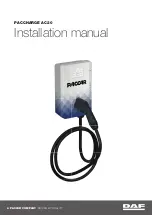
battery charger can work, but the output current will be automatically reduced
to protect the charger from high internal temperatures.
ÿ
Ventilated: Allow at least 4 inches (10 cm) of clearance around all sides of the battery
charger for air flow. Ensure the ventilation openings on the unit are not
obstructed. If mounting in a compartment, ventilate the compartment with
louvers or cut-outs to prevent overheating.
ÿ
Safe: Not to install in areas containing gasoline tanks or fittings.
ÿ
Close to AC junction box: Avoid the use of extended wire lengths if possible.
ÿ
Close to batteries: Avoid excessive cable lengths and use the recommended wire
lengths and sizes. Undersized or overly long cables may affect charging
accuracy.
3.2.1 DC Wiring
The DC wiring must meet the following requirements:
Recommend sections for battery cables:
12A ---- 4mm
2
minimum (AWG 11)
25A ---- 8mm
2
minimum (AWG 8)
40A ---- 13mm
2
minimum (AWG 6)
3.3 Installing
WARNING Shock and Energy Hazards
Be sure to read the safety guidelines and pay attention to all cautions and
warnings throughout the installation procedure. The installer is
responsible for ensuring compliance with the installation codes for your
particular application.
Disconnect all source of AC and DC power before proceeding.
CAUTION Reverse Polarity
Before making the final DC connection, check the cable polarity at both
the battery and the charger. Positive must be connected to positive;
negative must be connected to negative.









































